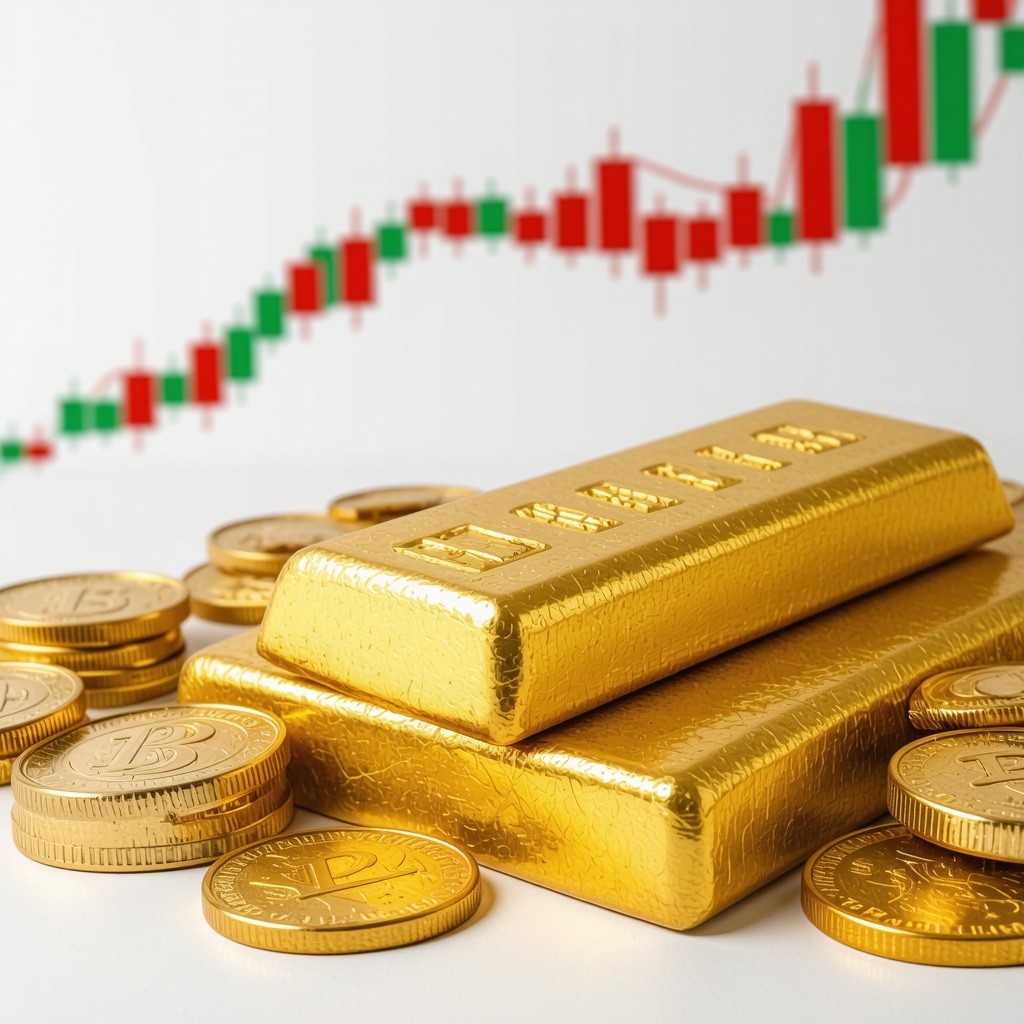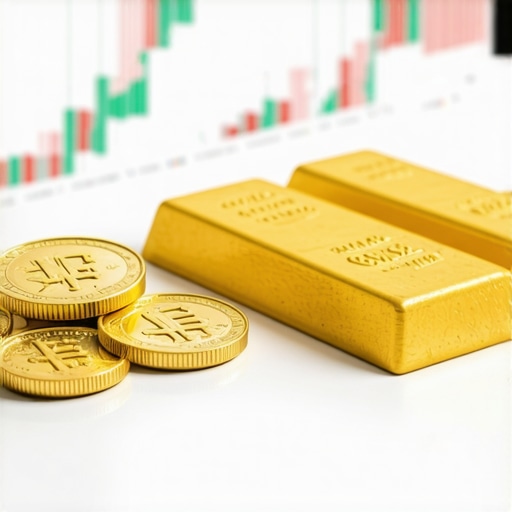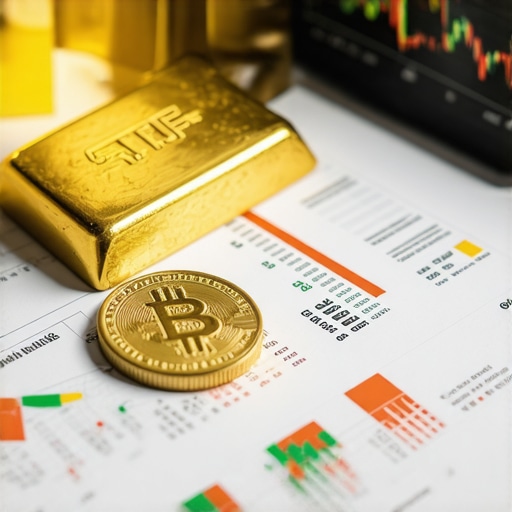Unveiling the Allure of Gold: More Than Just a Shiny Metal
Gold has long been revered not only for its intrinsic beauty but as a cornerstone of wealth preservation and portfolio diversification. In an era marked by economic volatility and fluctuating markets, investors increasingly turn to gold investments to anchor their portfolios against uncertainty and inflationary pressures. Yet, the world of gold investing is multifaceted, ranging from tangible bullion to sophisticated financial instruments, each with distinct benefits and risks. This guide dives deep into the various types of gold investments, illuminating how savvy investors can leverage these options to build resilient, diversified portfolios.
Physical Gold: Tangible Security with Historical Gravitas
Physical gold, encompassing coins and bars, remains the most traditional form of investment. Its appeal lies in direct ownership, immunity to digital vulnerabilities, and a palpable sense of security. Gold coins, such as the American Gold Eagle or Canadian Maple Leaf, offer liquidity and recognized authenticity, while gold bars provide cost efficiency for larger investments. However, investors must consider storage and insurance costs, as well as the nuances of verifying authenticity to avoid counterfeit risks. For beginners eager to explore physical gold safely, resources like best physical gold investment options: bars vs coins offer invaluable guidance.
Gold ETFs and Mutual Funds: Convenient Exposure Without Physical Handling
For investors seeking gold exposure without the logistics of handling bullion, gold exchange-traded funds (ETFs) and mutual funds present a compelling alternative. These instruments track gold prices or gold-related assets, enabling fractional ownership and easy liquidity. ETFs such as SPDR Gold Shares facilitate real-time trading on stock exchanges, blending convenience with diversification. Mutual funds might invest in gold mining companies or physical gold reserves, offering indirect exposure with professional management. It’s essential to evaluate expense ratios and fund composition to align with investment goals. For a detailed comparison, the article Gold ETFs vs Gold Mutual Funds: Which Offers Better Returns sheds light on these nuances.
Gold Mining Stocks: Harnessing Growth Potential Amid Risks
Investing in gold mining companies can amplify gains beyond gold price movements, as profitability hinges on operational efficiency and exploration success. However, mining stocks introduce company-specific risks such as management performance, geopolitical exposure, and commodity cost fluctuations. Selecting winners requires thorough analysis of financial health, reserve quality, and market positioning. This approach suits investors with higher risk tolerance seeking growth alongside gold’s defensive qualities. Those interested in mining stock strategies may find Gold Mining Stocks: How to Choose Winners in 2025 a valuable resource.
What Are the Strategic Advantages of Incorporating Different Gold Investment Types into a Single Portfolio?
Combining physical gold, ETFs, and mining stocks can harness the unique strengths of each, optimizing risk-adjusted returns. Physical gold serves as a tangible hedge against systemic shocks, ETFs offer liquidity and cost efficiency, while mining stocks provide growth potential. Diversification across these types mitigates idiosyncratic risks and aligns with varying investment horizons and liquidity needs. For instance, during economic downturns, physical gold often retains value, whereas mining stocks may underperform. Conversely, a bullish gold market can uplift mining equities disproportionately. This layered approach exemplifies sophisticated portfolio construction, balancing stability and opportunity.
Embracing Gold IRAs for Long-term Retirement Security
Gold Individual Retirement Accounts (IRAs) merge the tax advantages of retirement accounts with the stability of gold investments. These specialized IRAs allow investors to hold physical gold or gold-related assets within a tax-advantaged framework, enhancing portfolio resilience against inflation and market downturns. Setting up a gold IRA requires compliance with IRS regulations and trusted custodianship. Novices can explore comprehensive steps in How to Start Investing in Gold IRAs for Retirement Growth to navigate this avenue confidently.
Leveraging Authoritative Market Analyses for Informed Decisions
Informed gold investing benefits immensely from understanding market dynamics, including supply-demand trends, central bank activities, and macroeconomic forces. The World Gold Council and financial institutions regularly publish insights that help decode price movements. For instance, central banks’ increasing gold reserves can signal bullish price trends, while mining supply constraints may tighten availability. Staying attuned to these factors, as detailed in Analyzing Central Bank Gold Purchases for Market Forecasts, empowers investors to time entries and adjust exposures prudently.
If this exploration of gold investment avenues piqued your interest, share your experiences or questions below to foster a vibrant discussion among fellow investors eager to diversify with gold.
For further deep dives into gold investment strategies and forecasts, explore Choosing the Best Types of Gold Investments for Your Portfolio and Gold Price Forecast 2026: What Investors Should Expect.
Authoritative reference: The World Gold Council’s comprehensive reports on gold as an investment provide foundational and up-to-date market insights (https://www.gold.org/).
Understanding Gold Price Drivers: Beyond the Basics
Gold prices are influenced by a complex interplay of factors beyond simple supply and demand. Macroeconomic indicators such as inflation rates, interest rates, and currency strength play pivotal roles. For example, when real interest rates fall, gold often becomes more attractive because it does not yield interest itself but preserves purchasing power. Additionally, geopolitical tensions and financial market volatility frequently drive investors toward gold as a safe haven asset. For a comprehensive analysis of these influences, Key Gold Market Analysis Insights Impacting 2024 Prices provides an expert breakdown of current trends.
Gold Futures and Options: Leveraging Sophisticated Trading Instruments
For investors seeking to capitalize on short- to medium-term gold price movements, futures contracts and options offer leveraged exposure. Futures allow investors to agree on a price today for gold delivery in the future, enabling hedging or speculation. Options provide the right, but not the obligation, to buy or sell gold at a set price before a specific date. These instruments require a robust understanding of market mechanics and risk management, as leverage can amplify both gains and losses. Those interested in mastering these tools may find it valuable to explore Ultimate Guide to Gold Futures: How to Trade for Consistent Wins.
Integrating Gold in Multi-Asset Portfolios: Strategic Considerations
Integrating gold into a diversified portfolio involves assessing correlations with other asset classes. Historically, gold has shown low or negative correlation with equities and bonds, which enhances its role as a diversification tool. However, gold’s performance can vary depending on economic cycles. Portfolio managers often allocate 5-10% of total assets to gold or gold-related instruments to optimize risk-adjusted returns. This allocation strategy is supported by modern portfolio theory, which emphasizes balancing assets to mitigate volatility while seeking growth.
How Can Advanced Investors Optimize Gold Allocation Amid Changing Market Conditions?
Advanced investors continually adjust their gold allocation by monitoring economic indicators, geopolitical risks, and monetary policies. Dynamic strategies might include increasing gold holdings during periods of heightened inflation expectations or expanding exposure to mining stocks when commodity cycles are favorable. Moreover, utilizing a combination of physical gold, ETFs, and derivatives can tailor risk profiles and liquidity preferences. Leveraging expert market forecasts, like those from the World Gold Council, enables informed decisions that align with evolving market landscapes.
Engage with our community by sharing your strategies or questions on gold investment. Your insights contribute to a richer dialogue and help others navigate this multifaceted market. For further expert guidance on building resilient gold portfolios, consider reviewing How to Build a Safe Gold IRA Portfolio for Long-Term Gains and Effective Gold Investment Strategies to Hedge Economic Risks.
Decoding Geopolitical Influences: How Global Events Reshape Gold Valuations
Gold’s status as a geopolitical barometer is well-documented, yet the intricate mechanisms through which international tensions, trade disputes, and diplomatic shifts affect gold prices often elude even seasoned investors. When geopolitical unrest escalates, capital tends to flow into safe-haven assets, with gold often benefiting from sudden demand surges. But beyond immediate market reactions, sustained geopolitical uncertainties can alter central banks’ reserve strategies, prompting increased gold accumulation that exerts long-term upward pressure on prices. For example, the persistent conflicts in key mining regions can disrupt supply chains, tightening physical availability and amplifying price volatility. These dynamics underscore the necessity for investors to monitor geopolitical developments closely, integrating geopolitical risk assessments into their gold investment models to anticipate both short-term shocks and structural market shifts.
Strategic Use of Gold Derivatives: Sophisticated Hedging and Leverage Opportunities
While futures and options have been introduced, a deeper dive into advanced derivatives strategies reveals a spectrum of opportunities tailored for expert investors aiming to optimize risk-adjusted returns. Instruments such as gold swaps, forwards, and structured products enable nuanced exposure, permitting precise hedging against price fluctuations or speculative positioning with controlled risk parameters. For instance, employing options spreads can reduce premium costs while maintaining directional bets, whereas swaps facilitate currency risk management when gold is denominated in foreign currencies. Mastery of these instruments requires rigorous quantitative analysis and an understanding of market microstructure, as missteps can lead to outsized losses due to leverage and counterparty risks. Resources like the CME Group’s Precious Metals Trading Education provide comprehensive frameworks for developing such expertise.
What Risk Management Frameworks Are Essential When Employing Leveraged Gold Instruments?
Leveraged gold instruments, while offering amplified gains, inherently carry elevated risks including margin calls, liquidity crunches, and counterparty default. Effective risk management starts with setting clear position limits and stop-loss orders aligned with portfolio risk tolerance. Diversification across uncorrelated assets can cushion volatility spillovers, while stress testing portfolios against extreme price scenarios ensures preparedness for tail risks. Additionally, continuous monitoring of margin requirements and maintaining adequate liquidity buffers are critical to avoid forced liquidations. Incorporating scenario analysis that factors in geopolitical events, central bank interventions, and macroeconomic shocks sharpens decision-making. Institutional frameworks often leverage Value at Risk (VaR) models calibrated specifically for commodity derivatives to quantify potential losses under normal and stressed conditions. Ultimately, robust governance and disciplined execution underpin successful leveraged gold trading strategies.
Incorporating Environmental, Social, and Governance (ESG) Considerations in Gold Investing
As sustainability takes center stage in investment decision-making, gold investors increasingly evaluate ESG factors related to mining operations and supply chains. Responsible sourcing, minimizing ecological footprints, and ensuring fair labor practices have become pivotal criteria influencing gold asset valuations and investor preferences. Notably, ESG-compliant gold mining companies may command premium valuations due to reduced regulatory risks and stronger community relationships, enhancing long-term operational stability. Conversely, exposure to mines with poor ESG records can trigger reputational damage and financial penalties. Investors aiming to align portfolios with ESG principles can explore certified conflict-free gold or funds targeting sustainable mining enterprises. The Responsible Minerals Initiative offers industry standards and transparency tools vital for ESG due diligence in the gold sector.
Engage deeper with these advanced gold investment strategies and share your insights or challenges in implementing sophisticated portfolio techniques. Your contributions enrich the collective expertise and support a community striving for excellence in gold asset management.
Integrating ESG Principles into Gold Investment Decisions: Aligning Ethics with Returns
In today’s investment landscape, incorporating Environmental, Social, and Governance (ESG) criteria into gold portfolio construction transcends ethical considerations, evolving into a strategic imperative. ESG integration not only mitigates reputational and regulatory risks but also enhances long-term asset stability. Investors who scrutinize mining companies’ adherence to responsible sourcing, community engagement, and environmental stewardship often uncover opportunities for superior risk-adjusted returns. For instance, ESG-compliant gold producers typically demonstrate enhanced operational efficiencies and access to capital at favorable terms, underpinning more resilient cash flows amid sector volatility. The Responsible Minerals Initiative offers rigorous frameworks and transparency tools essential for discerning investors committed to ESG due diligence in gold mining operations.
Advanced Derivatives Strategies: Precision Tools for Hedging and Speculation
Beyond basic futures and options, expert investors employ sophisticated derivatives structures such as butterfly spreads, collars, and swaps to fine-tune exposure and manage downside risks. These instruments afford the ability to hedge price volatility with calibrated premium outlays or exploit arbitrage opportunities across correlated markets. Gold swaps, for instance, enable effective management of currency and interest rate risks when dealing with internationally denominated assets, while structured products can tailor payoffs to specific investor risk profiles. Mastery of these strategies demands comprehensive quantitative modeling and vigilant risk controls to navigate the complexities of margin requirements and counterparty exposures. The CME Group’s Precious Metals Trading Education platform provides an authoritative, detailed curriculum for professionals seeking to deepen their derivatives expertise.
How Can Institutional Investors Implement Robust Risk Management Frameworks for Leveraged Gold Derivatives?
Institutional investors must adopt multifaceted risk management frameworks when engaging with leveraged gold derivatives. This involves setting stringent position limits aligned with overall portfolio volatility targets and employing dynamic stop-loss mechanisms responsive to market liquidity and price shocks. Stress testing using scenario analyses that incorporate geopolitical disruptions, central bank policy shifts, and commodity supply shocks is vital to anticipate extreme tail risks. Additionally, continuous monitoring of margin calls and maintaining sufficient liquidity buffers are essential to mitigate forced liquidation risks. Quantitative tools such as Value at Risk (VaR), Conditional VaR, and scenario-based simulations calibrated to gold market idiosyncrasies provide critical insights into potential loss magnitudes. Governance structures must enforce rigorous oversight, ensuring adherence to risk limits and transparent reporting. Such comprehensive frameworks underpin sustainable leveraged trading strategies that balance opportunity with prudence.
Dynamic Portfolio Optimization: Navigating Gold’s Role Amid Market Volatility
Dynamic asset allocation models increasingly incorporate gold as a tactical component responsive to evolving macroeconomic and geopolitical conditions. Utilizing quantitative signals—such as inflation breakeven rates, real interest rate trajectories, and geopolitical risk indices—portfolio managers adjust gold exposures to optimize risk-adjusted returns. For example, during inflationary surges or escalating geopolitical tensions, tactical overweighting of physical gold and mining equities can enhance portfolio resilience. Conversely, in deflationary or stable scenarios, reducing gold exposure in favor of growth assets may be prudent. Incorporating machine learning algorithms to analyze historical price patterns and sentiment data further refines timing and allocation decisions. This nuanced approach exemplifies cutting-edge portfolio management techniques that leverage gold’s multifaceted characteristics as both a hedge and growth asset.
For practitioners eager to elevate their gold investment acumen, engaging with the World Gold Council’s latest analytical reports and industry whitepapers is invaluable (World Gold Council). Share your advanced strategies or questions below to deepen the discourse within our expert community, fostering collective mastery in navigating gold’s complex investment landscape.
Frequently Asked Questions (FAQ)
What distinguishes physical gold from gold ETFs in terms of investment security?
Physical gold provides direct ownership of tangible assets, offering immunity from digital or counterparty risks but entails storage and insurance costs. Gold ETFs, on the other hand, grant convenient, liquid exposure to gold prices without physical handling, though they carry counterparty and management risks. Investors prioritize physical gold for safe-haven security and ETFs for ease of trading and diversification.
How do gold mining stocks differ in risk and return compared to direct gold investments?
Gold mining stocks offer leveraged exposure to gold prices plus company-specific growth potential, influenced by operational efficiency, geopolitical factors, and management quality. This amplifies both upside returns and risks compared to holding physical gold or ETFs, which track gold prices more directly. Mining stocks suit investors with higher risk tolerance seeking capital appreciation.
What are the key advantages of incorporating gold IRAs into a retirement portfolio?
Gold IRAs combine the inflation-hedging and diversification benefits of gold with tax-advantaged retirement account structures. This enables long-term wealth preservation while complying with IRS regulations. They help protect retirement savings against currency devaluation and market downturns, but require careful custodian selection and understanding of regulatory requirements.
How can geopolitical events influence gold prices beyond immediate market reactions?
Geopolitical tensions often trigger safe-haven demand spikes, but sustained conflicts or trade disputes can lead central banks to increase gold reserves, tightening physical supply and imposing structural price pressures. Additionally, disruptions in mining regions can constrain supply chains, exacerbating volatility. Investors should integrate geopolitical risk assessments into their gold strategies for both short- and long-term outlooks.
What risk management practices are essential when trading leveraged gold derivatives?
Effective risk management includes setting strict position limits, using stop-loss orders, maintaining liquidity buffers, and conducting stress tests with scenario analyses incorporating geopolitical and macroeconomic shocks. Employing quantitative tools like Value at Risk (VaR) tailored for commodity derivatives and enforcing robust governance frameworks helps mitigate margin calls, counterparty risks, and forced liquidations.
How do ESG considerations impact gold investment decisions and valuations?
ESG factors are increasingly critical, as responsible mining practices reduce regulatory and reputational risks and can command valuation premiums. Investors focusing on ESG-compliant gold assets may benefit from enhanced operational stability and access to capital. Certification programs and transparency initiatives, like those from the Responsible Minerals Initiative, are vital for due diligence and aligning portfolios with sustainability goals.
What strategies enable dynamic portfolio optimization including gold amid changing market conditions?
Utilizing quantitative indicators such as inflation breakeven rates, real interest rate movements, and geopolitical risk indices allows investors to tactically adjust gold exposure. Machine learning models analyzing price patterns and sentiment data further refine timing. This dynamic approach balances gold’s hedge properties with growth opportunities, enhancing risk-adjusted returns amid volatility.
Why should investors consider advanced derivatives strategies beyond basic futures and options?
Advanced strategies like butterfly spreads, collars, and swaps provide nuanced risk management and tailored payoffs, enabling cost-efficient hedging and arbitrage opportunities. They help manage currency and interest rate risks, optimize premium expenditures, and exploit market inefficiencies. Mastery requires quantitative expertise and disciplined risk controls to navigate leverage and counterparty exposures safely.
How can investors verify the authenticity and quality of physical gold investments?
Verification involves purchasing from reputable dealers, utilizing assaying and hallmark certifications, employing testing technologies such as XRF analyzers or ultrasonic devices, and considering recognized coins and bars with government guarantees. Awareness of counterfeit risks and proper due diligence ensure secure physical gold ownership.
What role does gold play in multi-asset portfolio diversification?
Gold typically exhibits low or negative correlation with stocks and bonds, helping reduce overall portfolio volatility. Allocating 5-10% of assets to gold or gold-related instruments optimizes risk-adjusted returns and provides a buffer during economic downturns or inflationary periods. Its unique characteristics as both a store of value and a growth asset justify its inclusion in balanced portfolios.
Trusted External Sources
- World Gold Council (https://www.gold.org/): The premier global authority on gold market data, investment trends, and comprehensive research reports, offering critical insights into gold’s role in portfolios and market forecasts.
- Responsible Minerals Initiative (https://www.responsiblemineralsinitiative.org/): Provides industry standards and transparency tools essential for ESG due diligence in gold mining, supporting responsible sourcing and sustainable investment practices.
- CME Group Precious Metals Trading Education (https://www.cmegroup.com/education/courses/precious-metals-trading.html): Offers in-depth resources on gold futures, options, and advanced derivatives strategies, vital for mastering sophisticated trading instruments and risk management.
- International Monetary Fund (IMF) Reports on Gold Reserves: Delivers authoritative data on central bank gold holdings and macroeconomic analyses impacting gold supply-demand dynamics.
- Financial Times and Bloomberg Commodities Sections: Provide timely market news, geopolitical risk assessments, and expert commentary critical for informed gold investment decisions.
Conclusion
Gold remains an indispensable asset class for investors seeking portfolio resilience, inflation protection, and diversification. This comprehensive exploration revealed the multifaceted nature of gold investments—from tangible bullion and ETFs to mining equities and sophisticated derivatives—each serving unique strategic roles. Incorporating ESG considerations and geopolitical risk assessments further enriches investment quality and sustainability. Advanced portfolio optimization techniques and robust risk management frameworks empower investors to navigate gold’s complex market dynamics effectively. Embracing authoritative resources and engaging in informed discourse enhances mastery in gold investing. We invite you to share your perspectives, ask questions, and explore related expert content to deepen your understanding and capitalize on gold’s enduring value in your investment journey.











I really appreciate this comprehensive overview of the various gold investment options. As someone who has primarily invested in physical gold and ETFs, I find the insights into mining stocks and derivatives quite valuable for diversifying my strategy further. I agree with the point that combining different types of investments can help mitigate risks and capitalize on growth opportunities. Personally, I’ve been considering expanding into gold IRAs to ensure long-term retirement security, especially given the inflation concerns we’ve seen lately. Have others found that ESG considerations influence their choice of gold assets significantly? I’d be interested in hearing if sustainable mining practices have impacted investment decisions in your portfolios. Also, doing due diligence with reputable sources like the Responsible Minerals Initiative seems critical in this process. Overall, this post reinforces the importance of a well-rounded approach—balancing tangible assets, financial instruments, and ESG factors for resilience and growth. Would love to hear others’ experiences with integrating these diverse options into their gold investments.
This article offers an insightful deep dive into the multifaceted world of gold investments, which I find especially relevant today as market volatility remains high. I’ve primarily been comfortable with physical gold, but I recently started exploring gold ETFs and mining stocks to diversify further. One challenge I face is understanding the timing—how to effectively balance physical assets with more liquid instruments like ETFs, especially during rapid market shifts. I also wonder how other investors are integrating ESG considerations—I’ve noticed some funds now emphasize sustainability, which can impact returns but also aligns with my values. The role of geopolitical events, as discussed, is another complex piece; during recent tensions, gold prices spiked but then corrected quickly. Do you all have strategies for adjusting allocations in real-time to capitalize on these swings without overreacting? Would be great to hear how others are approaching this dynamic environment and blending different gold investment products for optimal resilience.